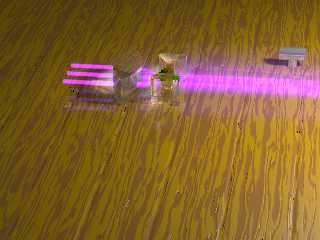|
 |
some more glass, with 2d curves.
also lens focal length.
#declare maglass2 =
intersection {
cylinder { <8,0,0>, <8,4,0> 10 }
cylinder { <-8,0,0>, <-8,4,0> 10 }
material { m_glass } photons { target reflection on refraction on }
}
object { maglass2 translate <-6,0,10> }
#declare concav_glass2 =
difference { box { <-2,0,-5>,<2,4,5> }
cylinder { <-5.5,-0.1,0>, <-5.5,4.1,0> 5 }
cylinder { <5.5,-0.1,0>, <5.5,4.1,0> 5 }
material { m_glass } photons { target reflection on refraction on }
}
object { concav_glass2 translate <0,0,10> }
#declare lens_focal_len = function(r1,r2,_ior,d) {
// Thin lens equation
// 1 / ((_ior-1) * ((1 / r1)-(1 / r2)))
1 / ((_ior-1) * (((1 / r1)-(1 / r2)) + (((_ior-1) * d) / (_ior * r1 * r2)) ))
}
// The signs of the lens' radii of curvature indicate whether the
// corresponding surfaces are convex or concave. If R1 is positive
// the first surface is convex, and if R1 is negative the surface
// is concave. The signs are reversed for the back surface of the lens:
// if R2 is positive the surface is concave, and if R2 is negative the surface
is convex.
// lens_focal_len(-1.75,1.75,1.5,0.2) = -1.717289
// lens_focal_len(-5,5,1.5,1) = -4.83871
// concave
// lens_focal_len(4,-4,1.5,1.6) = 4.28572
// lens_focal_len(10,-10,1.5,4) = 10.71429
// convex
this image:
2 lenses at a distance of 6 (arbitrary)
lens_focal_len(10,-10,1.5,4) = 10.71429
lens_focal_len(-5,5,1.5,1) = -4.83871
Post a reply to this message
Attachments:
Download 'laserfocus_0.png' (126 KB)
Preview of image 'laserfocus_0.png'

|
 |




![]()